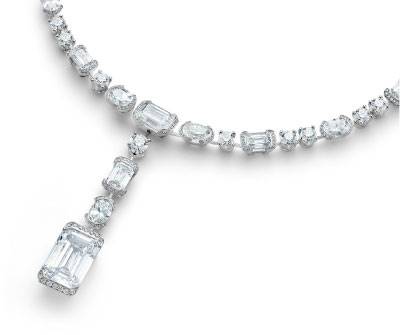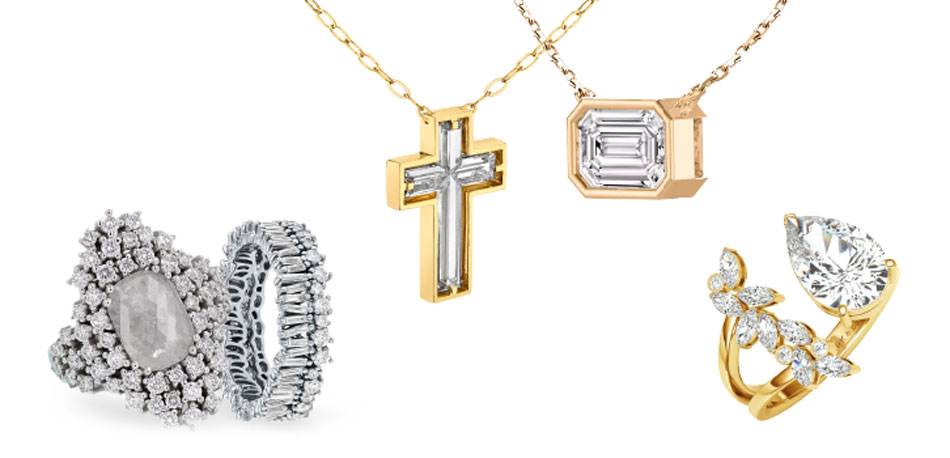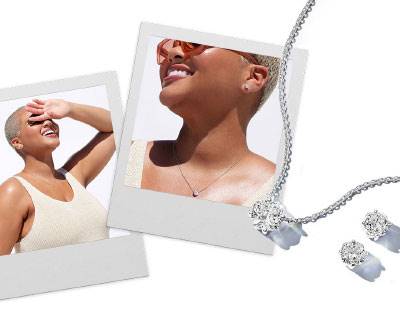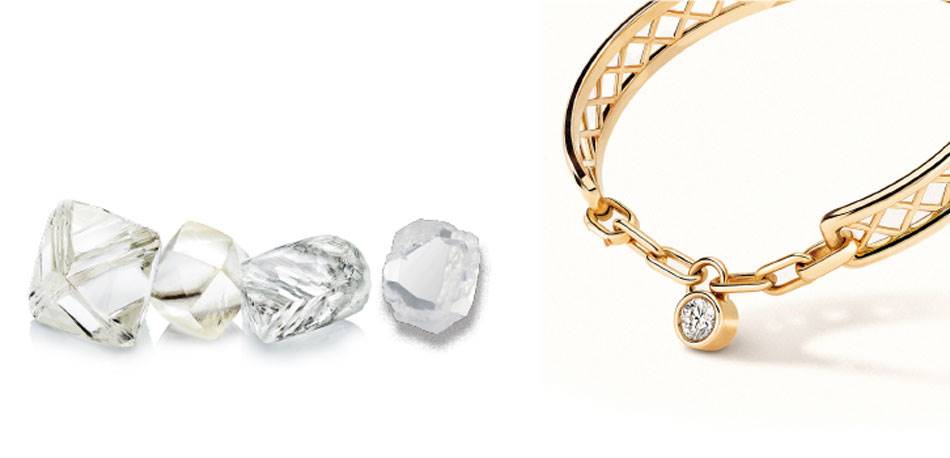 As retailers bravely march towards the most significant sales period of the year – December – it’s important not only to prepare for the future but also to reflect on how significant of year 2022 has been for the world of white diamonds and diamond jewellery.
As retailers bravely march towards the most significant sales period of the year – December – it’s important not only to prepare for the future but also to reflect on how significant of year 2022 has been for the world of white diamonds and diamond jewellery.
Of course everything changed in 2020 – the COVID pandemic stopped international travel and trade suffered dramatically as a result.
As industry analyst Chaim Even Zohar explains “Twenty-twenty always had a nice ring to it, and in the run-up to it, many entities, both companies and international bodies drew up their vision statements. However, 2020 turned out to be quite the contrary and will be remembered for a long time for all the wrong reasons.”
Then 2021 was the year the jewellery industry prayed would bring about a reversal of all that unfolded in the preceding year.
For many Australians, restrictions remained in place – however internationally, the diamond sector rebounded.
“The entire industry not only saw a surge in sales after the COVID outbreak in 2020, but also experienced one of its most profitable years, something for which it had been yearning. 2021 helped the industry ‘right-size’ its inventories and bring the overall business model back in line with what it should be,” writes industry expert Pranay Narvekar.
2022 came around, the new year presented itself as an opportunity to return to normality and in the opening months all early signs were cautiously optimistic – until February. Russia invaded Ukraine, prompting governmental and corporate powers to take action, levying sanctions against the country responsible for more than one third of the world’s supply of rough.
Now, with three quarters of 2022 passed, diamond market sentiment remains as mixed as could be.
Edahn Golan, an industry analyst with more than two decades experience studying the market, echoed this sentiment – particularly in relation to jewellery demand within the US.
“Jewellery sales boasted an impressive performance in the first half of 2022. Sales rose nearly across the board – a particularly impressive act against the excellent performance of 2021,” Golan says.
“However, as the months went by, sales deteriorated until they fell behind in June.
“The average retail price per unit fluctuated during the six-month period, and yet, stayed at a double-digit rise compared to the previous year. There is only one explanation for this: A sizeable chunk of American consumers are continuing to display a healthy appetite for jewellery, with a specific craving for higher-end goods.”
Global diamond production recovered in 2021 following the impact of the international pandemic, however, according to Golan the revival didn’t reverse the long term trend of production slowly declining.
“The repeated - and often delayed - forecast that production will fall and consumer demand will rise is starting to materialize. But will demand continue to grow?” asks Golan.
“That is really in the hands of the diamond industry and its efforts to market diamonds to a generation of consumers that has concerns about the environment.
He added “The average value of rough diamonds exported by producers was up to a record high against rising demand and energy costs. But is it sustainable? With a decline in polished diamond prices, producers may be forced to reduce prices.”

| Suzanne Kalan; Vrai; Lark & Berry |
Conflicting forces
In order to get an accurate read on a complex situation, it’s often recommended that one goes back to the basics.
Martin Rapaport – chairman of the Rapaport Group – says that the key to understanding the confusion and uncertainty of the international diamond industry is to grasp the role played by contrasting and conflicting powers.
“We are going through a period of unprecedented changes and it can be very confusing and difficult to understand. While we travel through this period of unprecedented uncertainty, you might want to take the time to think about what it is we do know,” he explains.
“We have data that tells us that there is a certain number of diamond mines and diamond factories on the supply side. On the demand side, there are a certain number of stores, a certain number of consumers and each year, there’s a certain number of marriages – we have these facts.
 |
| Above: 'This summer, pack light' campaign. |
He continues: “We must remember that it is not supply that sets prices. Demand is what sets prices.”
Tighter supply of rough diamonds has traditionally led to higher prices – an outcome some experts foreshadowed as a result of Russia’s exclusion from a significant portion of the international market. However, at the same time as sanctions have been installed against Russia, the economies of the US, Australia and other western nations have been weakened for a range of reasons - perhaps the most prominent of all being inflation stemming from the stimulus measures which kept consumers active during the lockdowns of 2021.
Inflationary pressure leads to a decrease in consumer desire to spend on luxury items such as diamond jewellery, and as demand falls, so do prices – which when combined with the tension of supply shortages, leads to a contradictory and difficult to read market.
“Tighter rough supply implies higher prices, however, weaker demand for polished diamonds leads to lower prices. There’s a conflict here and that’s the reason why things seem so confusing right now,” Rapaport says.
“Prices are set during an interaction between supply and demand and we must remember it’s mostly demand that sets price.”
Bifurcation
Bifurcation became a hot topic in the diamond industry during 2022. Never heard of the word?
Birfurcation is the separation of one entity into two distinct segments, and in terms of economics, this traditionally involves definitions of high and low value, which is why it started to become a talking point among diamond experts.
Market bifurcation occurs when disjointed market movements move in opposite directions, or when high and low quality securities move out of sync, causing the two segments to operate and perform independently within the market.
One example of birfucation is US clothing retailer GAP announcing that the Old Navy brand would be separated from stores and sold independently. At the time, GAP executives said the move would allow Old Navy to expand under a separate individualised business strategy.
Other examples to consider are luxury and economy brands of cars; think Toyota with Lexus and Hyundai
with Genesis.
A number of voices in the diamond industry are predicting significant bifurcation within the market –
for a range of reasons.
One of those voices is analyst Paul Zimnisky, who recently espoused the view that in five years time the market will be significantly separated, specifically from a retail perspective.
“In general, I think natural diamond prices will be higher and I think lab-created diamond prices will be lower by the time we reach 2027,” Zimnisky says.
“I think the differentiation between the two products will be more apparent in the eyes of consumers five years from now.
“Speaking of natural diamonds more specifically, I think most medium and larger stones will be sold with a certificate of origin, and the supply chain will be bifurcated between Russian and non-Russian goods.”
Internal
Rapaport forecasts a similar level of separation for consumers. Cheaper and common diamond products are susceptible to change based on economic forces such as inflation and strong or weak consumer confidence, while at the luxury level, these pressures are less impactful.
“Inexpensive diamonds will be very sensitive to price increases. Then you’ll see the bigger diamonds, where people just don’t care about the prices,” he explains.
“If the prices increase, they’re going to want to buy more of them in an inflationary environment. So we’re looking at interesting market scenarios here. We’re looking at changes. We’re looking at a bifurcation or separation of markets.”
External
With Russia excluded from the international landscape, Chaim Even Zohar warned of a divided market in IDEX’s report,
Lamenting the natural diamond producers’ missed income.
“It is clear that for the diamond industry, sanctions are here to stay and the industry needs to be ready for the long haul, and choose which side to take. The sanctions will probably continue even after the conflict stops,” he explains.
“In the event that the industry transitions into a multi-polar environment, companies clearly need to take sides, having to scale down their business in order for them to continue being compliant.
“With the current regulations in place, the industry is likely to be split down the middle, with some companies abiding by the sanctions and other companies dealing in Russian diamonds, but not supplying them to the developed world.”

| Natural diamond roughs; Lab grown diamond rough; Courbet |
Russian Rebound
Many were quick to question the effectiveness of economic sanctions placed against mining juggernaut Alrosa following
the Ukraine invasion.
Rapaport has been one vocal sceptic.
“Fundamentally, the sanctions on the Russian diamond industry as legally applied by governments are nonsense,” he says.
“It’s a form of government greenwashing, if you will – they’re saying ‘look at us, we’re doing something – but they’re not doing anything.”
He clarifies: “Russian diamonds and Russian rough will simply head to countries like China that are not imposing sanctions.
The governments have left a huge loophole in place [the definition of transformed diamonds] regarding diamonds and while they make a lot of noise, it’s all nonsense.”
Recent reports that Russian rough diamond sales remain healthy would seem to vindicate the sceptics.
Despite these sanctions remaining in place, Bloomberg News revealed in August that Alrosa’s rough diamonds sales each month continues to be around $US250 million.
Comparatively, in January of this year - prior to the invasion - its sales were approximately $US325 million a fact that was addressed by a further report in September titled ‘Russia’s Secret Gem Sales Are Dividing the Diamond World’.
“The secretive sale of Russian diamonds, worth hundreds of millions of dollars every month, is fracturing the global trade that stretches from cutting factories in Mumbai to luxury stores on New York’s Fifth Avenue,” the report states.
“Many in the industry refuse to deal in Russian gems following the invasion of Ukraine and after mining giant Alrosa PJSC was hit with US sanctions. But there’s a handful of Indian and Belgian buyers who are snapping up large volumes at lucrative terms, getting to pick and choose the diamonds they need while others stay away.
“The deals are happening quietly, even for the famously secretive diamond world.”
Zimnisky was another early sceptic of the impact sanctions would have on Russian trade, suggesting that changes to the landscape may open the door to new threats.
“I think eventually Russian natural diamond supply will find a home, whether it be in China or the Middle East for example,” he told Jeweller in July.
“[In the meantime] Lab-created diamond supply will continue to increase as new players keep entering the space and as existing producers ramp up production capacity and relative yields.”
Revisiting the issue in September, Zimnisky says retail performance during the holiday season will understandably have an enormous impact on how 2023 unfolds.
“I think that current circumstances could benefit non-Russian producers simply given the supply and demand balance. For example, the ‘West’ represents around 75 per cent of global end-consumer diamond demand, but only 65-70 per cent of global diamond supply comes from non-Russian sources.
“Given the global macro-economic conditions and China’s zero-COVID policy, demand and sentiment in the industry has cooled in recent months, which has taken some pressure off of the supply situation. However, if we have a holiday season that is anywhere on par with that of last year, I think the industry will run into natural diamond shortages as the industry restocks in early 2023.”
Brighter outlook
 As a small business, how do you set the appropriate price for a product?
As a small business, how do you set the appropriate price for a product?
Edahn Golan explored the battle between natural diamonds and lab-created diamonds in his report Lab Grown: All Fears Materialised.
“The diamond industry as a whole, natural and lab grown, has a lot on its plate,” he said.
“Both have financial issues to resolve, both need to improve their relevance in the eyes of consumers, and both need to ensure they are acting ethically and sustainably.
“No one side can claim sainthood and simply point blamingly at the other.
“The good news is the growing competition between the two is also forcing them to up their game. In that regard, this is a very welcome outcome.”
One crucial battleground between the two products continues to be marketing.
Lab-created diamond manufacturers were quick to begin selling the product under the mantle of ‘environmentally sustainable’ – regardless of whether or not their claims were accurate or truthful. Experts are urging natural diamond companies to begin marketing diamonds and diamond jewellery under a new unique narrative.
“Over the last few decades I think the natural diamond industry lost its way by allowing its product to sell at less-than-premium price points,” says Zimnisky.
“Diamonds arguably fall into the category of a ‘Veblen good’, meaning the higher the price the more desired they become.
Natural diamonds should be marketed as the highest-end luxury item you can buy, and higher prices support this perception.”
Golan says that the lab-created diamond industry will need to adopt similar tactics if it is to survive.
“Lab grown is very much sold as the ‘other diamond,’ often using negative context. A marketing program based on the - real or not - shortcomings of the original product is unsustainable,” he says.
“To succeed, lab grown needs to develop its own distinctive story. It’s not ‘forever’ or a creation of nature. And to be honest, ‘sustainable’ is not only a negative reference to the competing product, but it will also hopefully be a given in all aspects of our lives.”
He concludes: “Its physical attributes will soon be less of a story too. Once all lab grown are D colour and flawless, the only differentiating attribute will be brand. And brand is a story. Until lab grown secedes from natural, it will continue sinking in value: both monetary and perceptional.”
The Natural Diamond Council (NDC) is one organisation hoping to boost the public image of diamonds and diamond jewellery, beginning with a recently launched campaign featuring UK actress Lily James.
NDC CEO David Kellie says he fears the wider industry still fails to understand the importance of marketing. “I don’t believe that our industry institutions understand the downside of not supporting category marketing,” he says.
“The industry is not yet stepping up and recognising that we cannot be a successful industry in a luxury market without more aggressive support behind diamond category marketing.”
Wake up call
The fight between champions of natural and lab-created diamond networks is arguably as heated as ever and the tension exists for a good reason – livelihoods remain at stake and with the jewellery industry one of only a few industries where family connection to business remains strong, concepts of lineage and tradition are also at stake.
For those concerned about the future, Rapaport has a simple message.
“By the way – don’t freak out everybody, this is the way the world works,” he advises.“You’ve got winter and you’ve got summer. Nobody is surprised when it’s hot in the summer and cold during winter.
“We need to get used to the fact that things work in cycles and that we are now involved in a far greater economic system which involves factors such as inflation, interest rates, disposable income and the wealth effect.
“Diamonds are ping-pong balls floating in the ocean, always up and down, but hey - at least they’re floating!”
Read eMag